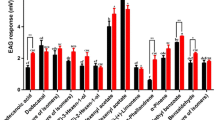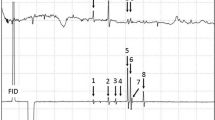Abstract
Experimental designs developed to address mixtures are suited ideally to many areas of experimental biology, including pheromone blend studies, because such designs address the confounding of proportionality and concentration intrinsic to factorial and one-factor-at-a-time designs. Geometric multivariate designs coupled with response surface modeling allowed us to identify optimal blends of a two-component pheromone for attraction and trap disruption of the leafminer moth, Phyllocnistis citrella, a major pest in citrus growing areas around the world. Field trials confirmed that the natural 3:1 blend of (Z,Z,E)-7,11,13-hexadecatrienal:(Z,Z)-7,11-hexadecadienal was most effective as an attractant for male moths. However, the response surface generated in mating orientation trials revealed that the triene component alone was more effective than the natural blend in disrupting trap catch. Each individual component was effective at disrupting orientation in field trials, but (Z,Z,E)-7,11,13-hexadecatrienal was approximately 13 times more effective, at the same concentration, compared with (Z,Z)-7,11-hexadecadienal alone. In addition, the application of geometric design and response surface modeling to field studies provided insight into a possible mechanism of mating disruption and supported sensory imbalance as the operating mechanism for this species.




Similar content being viewed by others
References
Anderson, M. J. and Whitcomb, P. J. 2005. RSM Simplified: Optimizing Processes Using Response Surface Methods for Design of Experiments. Productivity, New York.
Bartell, R. J. 1982. Mechanisms of communication disruption by pheromone in the control of Lepidoptera: a review. Physiol. Entomol. 7:353–364.
Bellas, T. E. and Bartell, R. J. 1983. Dose-response relationship for two components of the sex pheromone of lightbrown apple moth, Epiphyas postvittana (Lepidoptera: Tortricidae). J. Chem. Ecol. 9:715–725.
Belsley. D. A., Kuh, E., and Welsch, R. E. 1980. Regression Diagnostics: Identifying Influential Data and Sources of Collinearity. Wiley & Sons, New York.
Box, G. E. P. and Cox, D. R. 1964. An analysis of transformations (with discussion). J. Royal. Stat. Soc. Ser. B 26:211–246.
Box, M. J. and Draper, N. R. 1971. Factorial designs, the X’X criterion, and some related matters. Technometrics. 13:731–742.
Cardé, R. T. 1990. Principals of mating disruption, pp. 47–71, in Ridgway, R. L., Silverstein, R. M., and Inscoe, M. N. (eds.). Behavior-Modifying Chemicals for Pest Management: Applications of Pheromones and Other Attractants. Marcel Dekker, New York.
Cardé, R. T. and Minks, A. K. 1995. Control of moth pests by mating disruption: successes and constraints. Annu. Rev. Entomol. 40:559–585.
Charlton, R. E. and Cardé, R. T. 1981. Comparing the effectiveness of sexual communication disruption in the oriental fruit moth (Grapholitha molesta) using different combinations and dosages of its pheromone blend. J. Chem. Ecol. 7:501–508.
COOK, R. D. and WEISBERG, S. 1982. Residuals and Influence in Regression. Chapman and Hall, New York.
Cornell, J. A. 2002. Experiments with Mixtures. 3rd edn., Wiley & Sons, New York.
Evens, T. J. and Niedz, R. P. 2008. Are Hofmeister series relevant to modern ion-specific effects research? Scholarly Research Exchange vol. 2008, Article ID 818461, 2008. doi:10.3814/2008/818461
Flint, H. M. and Merkle, J. R. 1983. Pink bollworm (Lepidoptera: Belechiidae): communication disruption by pheromone composition imbalance. J. Econ. Entomol. 76:40–46.
Gottwald, T. R., Bassanezi, R. B., Amorim, L., and Bergamin-Filho A (2007) Spatial pattern analysis of citrus canker-infected plantings in São Paulo, Brazil, and augmentation of infection elicited by the Asian leafminer. Phytopathol. 97:674–683.
Heppner, J. B. 1993. Citrus leafminer, Phyllocnistis citrella, in Florida. Trop. Lepidoptera. 4:49–64.
Lapointe, S. L., Evens, T. J., and Niedz, R. P. 2008. Insect diets as mixtures: optimization for a polyphagous weevil. J. Insect. Physiol. 54:1157–1167.
Lapointe, S. L., Hall, D. G., Murata, Y., Parra-Pedrazzoli, A. L., Bento, J. M. S., Vilela, E., and Leal, W. S. 2006. Field evaluation of a synthetic female sex pheromone for the leafmining moth Phyllocnistis citrella (Lepidoptera: Gracillariidae) in Florida citrus. Fla. Entomol. 89:274–276.
Leal, W. S., Parra-Pedrazzoli, A. L., Cossé, A. A., Murata, Y., Bento, J. M. S., and Vilela, E. F. 2006. Identification, synthesis, and field evaluation of the sex pheromone from the citrus leafminer, Phyllocnistis citrella. J. Chem. Ecol. 32:155–168.
Miller, J. R., Gut, L. J., De Lame, F. M., and Stelinski, L.L. 2006a. Differentiation of competitive vs. non-competitive mechanisms mediating disruption of moth sexual communication by point sources of sex pheromone (Part 1): theory. J. Chem. Ecol. 32:2089–2114.
Miller, J. R., Gut, L. J., De Lame, F. M., and Stelinski, L. L. 2006b. Differentiation of competitive vs. non-competitive mechanisms mediating disruption of moth sexual communication by point sources of sex pheromone (Part 2): case studies. J. Chem. Ecol. 32:2115-2143.
Minks, A. K. and Cardé, R. T. 1988. Disruption of pheromone communication in moths: is the natural blend really most efficacious? Entomol. exp. appl. 49:25–36.
Moreira, J. A., McElfresh, S., and Millar, J. G. 2006. Identification, synthesis, and field testing of the sex pheromone of the citrus leafminer, Phyllocnistis citrella. J. Chem. Ecol. 32:169–194.
Myers, R. H. 1990. Classical and Modern Regression with Applications. 2nd edn, PWS-KENT, Boston.
Myers, R. H. and Montgomery, D. C. 2002. Response Surface Methodology: Process and Product Optimization Using Designed Experiments. 2nd edn., Wiley & Sons, New York.
Niedz, R. P. and Evens, T. J. 2008. The effects of nitrogen and potassium nutrition on the growth of nonembryogenic and embryogenic tissue of sweet orange (Citrus sinensis (L.) Osbeck). BMC Plant Biology 8:126.
Novak, M. A. and Roelofs, W. L. 1985. Behavior of male redbanded leafroller moths, Argyrotaenia velutinana (Lepitdoptera: Tortricidae), in small disruption plots. Environ. Entomol. 14:12–16.
Peña, J. E., Hunsberger, A., and Schaffer, B. 2000. Citrus leafminer (Lepidoptera: Gracillariidae) density: effect on yield of ‘Tahiti’ Lime. J. Econ. Entomol. 93:374–379.
Piepel, G. F. 1982. Measuring component effects in constrained mixture experiments. Technometrics. 24:29–39.
Roelofs, W. L. 1978. Threshold hypothesis for pheromone perception. J. Chem. Ecol. 4: 685–699.
Stelinski, L. L., Miller, J. R., and Rogers, M. E. 2008. Mating disruption of citrus leafminer mediated by a noncompetitive mechanism at a remarkably low pheromone release rate. J. Chem. Ecol. 34:1107–1113.
Weisberg, S. 1985. Applied Linear Regression. 2nd edn. Wiley & Sons, New York.
Witzgall, P., Stelinski, L., Gut, L., and Thomson, D. 2008. Codling moth management and chemical ecology. Annu. Rev. Entomol. 53:503–522.
Acknowledgments
We thank Evans Properties, Vero Beach, FL for use of their grapefruit groves. David Melius, Kelsey Stevens, Alex Pheneger, Kathy Moulton, Matt Hentz and Anthea Diamondis (USDA-ARS, Ft. Pierce) and Ian Jackson, Angel Hoyte and Wendy Meyer (UF, Lake Alfred) assisted with field trials. ISCA Technologies provided lures and SPLAT formulations. Partial funding was provided by USDA’s IR-4 Project.
Author information
Authors and Affiliations
Corresponding author
Rights and permissions
About this article
Cite this article
Lapointe, S.L., Stelinski, L.L., Evens, T.J. et al. Sensory Imbalance as Mechanism of Orientation Disruption in the Leafminer Phyllocnistis citrella: Elucidation by Multivariate Geometric Designs and Response Surface Models. J Chem Ecol 35, 896–903 (2009). https://doi.org/10.1007/s10886-009-9674-9
Received:
Revised:
Accepted:
Published:
Issue Date:
DOI: https://doi.org/10.1007/s10886-009-9674-9




